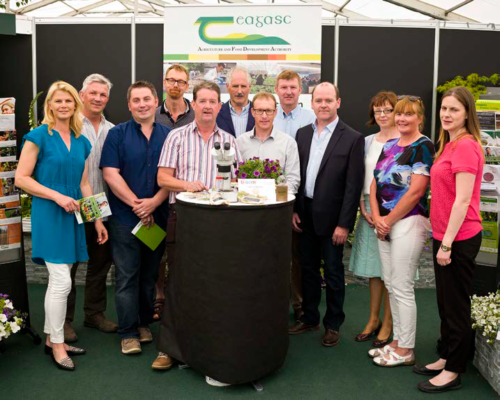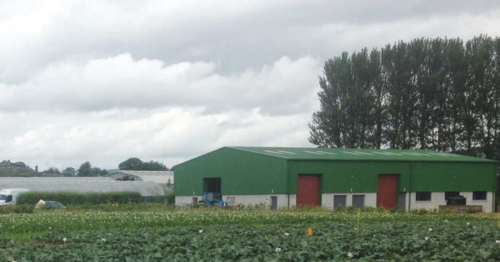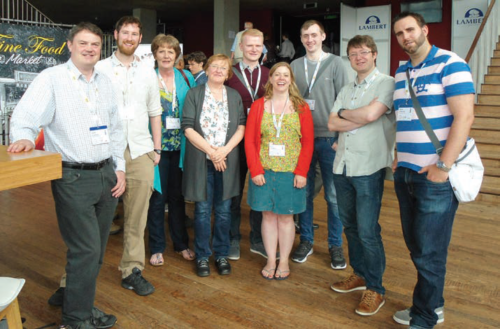Teagasc Horticulture at Bloom in the Park Teagasc horticulture exhibited at the 10th annual Bloom event in the Phoenix Park, Dublin. Teagasc’s two horticultural colleges, the College of Amenity Horticulture at the National Botanic Gardens, Dublin and Kildalton College, Piltown, Co. Kilkenny play a major role in horticultural education and training in Ireland. This year the colleges joined with the Teagasc Horticulture Development Department to highlight the value that Teagasc horticultural courses gain through strong links with research, advice and industry training undertaken by the Teagasc horticulture development department. Teagasc launched two publications at Bloom ‘Stepping Stones to a Career in Horticulture’ and ‘Greenhouse Salad Crops- a Guide for Home Gardeners both of which are free to download at www.teagasc.ie/publications. Louise Jones from the Teagasc College in the Botanics led the design of the Teagasc stand and together with colleagues Leo Finn, Christine Murray, Liam Foy and Philip Dunne put together a gold medal award winning stand for the first time ever at Bloom. Congratulations to all involved. ✽ |
Technical Updates‘Diamonds in the sky’ Everything about diamondback moth is small apart from the damage it does. Small green caterpillars hatch from tiny eggs laid on the underside of the leaf, which rapidly get eaten away leaving characteristic ‘window panes’. They attack all brassicas, especially cabbage, with the worst damage showing up on York cabbage. The damage stems from the sheer numbers of the insect – every plant in the field can get attacked. This migratory moth is native to southern Europe and gets carried in on high-pressure winds during the summer. It’s hugely destructive of brassica crops in hot countries and occasionally causes problems here in warm dry summers. It looks like 2016 could be another 2006, the last time Irish growers were plagued by this unwelcome visitor. The only way to control this pest is to get in early with an insecticide and spray frequently if pest pressure is high. Use something like Steward, Karate or Sitrine, with a high volume of water along with a sticker. ✽ |
Teagasc Education UpdateTeagasc offers full and part-time courses in Levels 5 and 6 in both its colleges. The conventional way to enter horticulture is through its Level 5 route, which is a Certificate in Horticulture. Students can then go on to complete the Level 6 Advanced Certificate in Horticulture, specialising in landscaping, nursery, sports turf or food production. There is also an increasing interest in part-time programmes. These operate as components of the Level 5 or Level 6 programmes, whereby an applicant can do an individual subject such as plant propagation or plant ID alone. Students could eventually build their components into a major award. For more information on this please contact each of the colleges individually. The colleges run throughout the summer so you can call up anytime and make an appointment to meet staff and discuss course options. See www.teagasc.ie for a full listing of all our course offerings, or visit us on stand ST18 at Glas 2016. ✽ |
National Spotted Wing Drosophila Monitoring Programme 2016In 2008 Drosophila suzukii (Spotted Wing Drosophila, abbreviated to SWD) was detected in three European countries (Italy, France and Spain) as well as in the United States (California). Its presence in the United Kingdom was first recorded in 2012. In August 2015 its presence in Ireland was confirmed, with samples trapped at a commercial fruit growing farm. D. suzukii, unlike most other Drosophila species, has the ability to lay its eggs in ripening and ripe fruit. This is possible due to its serrated ovipositor, which allows it to puncture the relatively hard skin of fruits and lay eggs in them. These puncture wounds become soft and sunken and can also allow secondary pathogens to infect fruit. Teagasc Horticulture Development Department has developed a monitoring programme to establish the extent and occurrence of SWD on Irish soft and stone fruit farms. A series of workshops have been arranged in the early part of this year with further workshops planned for late 2016. Stay tuned to the events section of Teagasc website for more information. ✽ |









